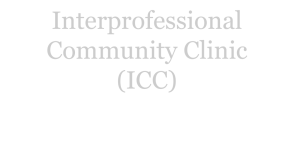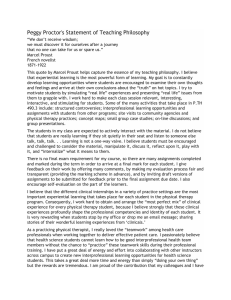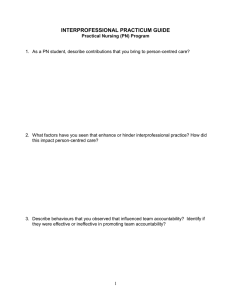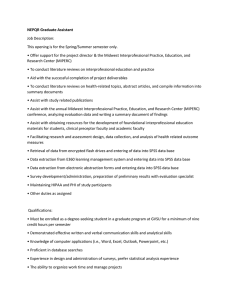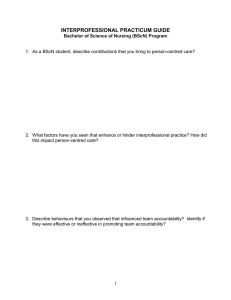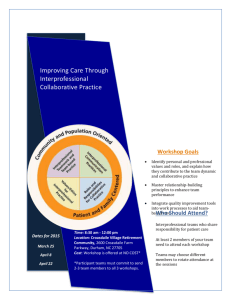Document 12341664
advertisement
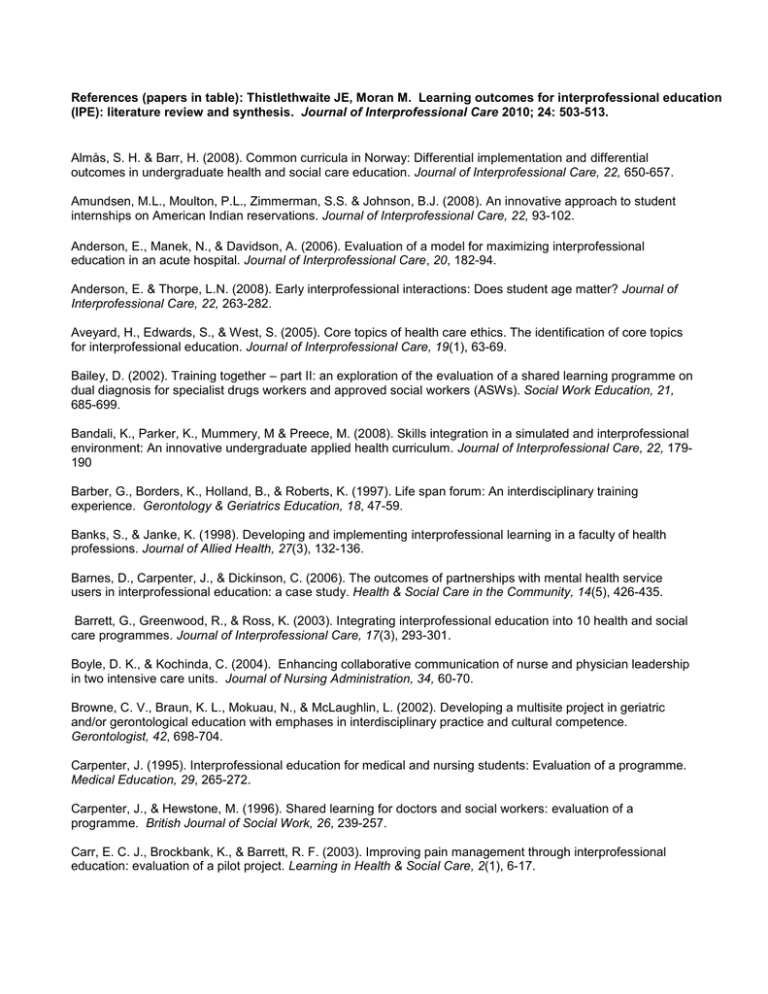
References (papers in table): Thistlethwaite JE, Moran M. Learning outcomes for interprofessional education (IPE): literature review and synthesis. Journal of Interprofessional Care 2010; 24: 503-513. Almås, S. H. & Barr, H. (2008). Common curricula in Norway: Differential implementation and differential outcomes in undergraduate health and social care education. Journal of Interprofessional Care, 22, 650-657. Amundsen, M.L., Moulton, P.L., Zimmerman, S.S. & Johnson, B.J. (2008). An innovative approach to student internships on American Indian reservations. Journal of Interprofessional Care, 22, 93-102. Anderson, E., Manek, N., & Davidson, A. (2006). Evaluation of a model for maximizing interprofessional education in an acute hospital. Journal of Interprofessional Care, 20, 182-94. Anderson, E. & Thorpe, L.N. (2008). Early interprofessional interactions: Does student age matter? Journal of Interprofessional Care, 22, 263-282. Aveyard, H., Edwards, S., & West, S. (2005). Core topics of health care ethics. The identification of core topics for interprofessional education. Journal of Interprofessional Care, 19(1), 63-69. Bailey, D. (2002). Training together – part II: an exploration of the evaluation of a shared learning programme on dual diagnosis for specialist drugs workers and approved social workers (ASWs). Social Work Education, 21, 685-699. Bandali, K., Parker, K., Mummery, M & Preece, M. (2008). Skills integration in a simulated and interprofessional environment: An innovative undergraduate applied health curriculum. Journal of Interprofessional Care, 22, 179190 Barber, G., Borders, K., Holland, B., & Roberts, K. (1997). Life span forum: An interdisciplinary training experience. Gerontology & Geriatrics Education, 18, 47-59. Banks, S., & Janke, K. (1998). Developing and implementing interprofessional learning in a faculty of health professions. Journal of Allied Health, 27(3), 132-136. Barnes, D., Carpenter, J., & Dickinson, C. (2006). The outcomes of partnerships with mental health service users in interprofessional education: a case study. Health & Social Care in the Community, 14(5), 426-435. Barrett, G., Greenwood, R., & Ross, K. (2003). Integrating interprofessional education into 10 health and social care programmes. Journal of Interprofessional Care, 17(3), 293-301. Boyle, D. K., & Kochinda, C. (2004). Enhancing collaborative communication of nurse and physician leadership in two intensive care units. Journal of Nursing Administration, 34, 60-70. Browne, C. V., Braun, K. L., Mokuau, N., & McLaughlin, L. (2002). Developing a multisite project in geriatric and/or gerontological education with emphases in interdisciplinary practice and cultural competence. Gerontologist, 42, 698-704. Carpenter, J. (1995). Interprofessional education for medical and nursing students: Evaluation of a programme. Medical Education, 29, 265-272. Carpenter, J., & Hewstone, M. (1996). Shared learning for doctors and social workers: evaluation of a programme. British Journal of Social Work, 26, 239-257. Carr, E. C. J., Brockbank, K., & Barrett, R. F. (2003). Improving pain management through interprofessional education: evaluation of a pilot project. Learning in Health & Social Care, 2(1), 6-17. Charles, G., Bainbridge, L., Copeman-Stewart, K., Art, S. T., & Kassam, R. (2006). The Interprofessional Rural Program of British Columbia 9IRPbc). Journal of Interprofessional Care, 20, 40-50. Charles, G., Bainbridge, L., & Gilbert, J. (2004). Interprofessional education and practice in the health and human services: the University of British Columbia Model. Vancouver, British Columbia: UBC. Clark, P. G. (2006). What would a theory of interprofessional education look like? Some suggestions for developing a theoretical framework for teamwork training. Journal of Interprofessional Care, 20, 577-89. Coleman, M. T., Roberts, K., Wulff, D., Van Zyl, R. & Newton, K. (2008). Interprofessional ambulatory primary care practice-based educational program. Journal of Interprofessional Care, 22, 69-84. Cooke, S., Chew, G., Boggis, C., & Wakefield, A. (2003). ‘I never realised that doctors were into feelings too': changing student perceptions through interprofessional education. Learning in Health and Social Care, 2, 137146. Cooper, H., Carlisle, C., Gibbs, T., & Watkins, C. (2001). Developing an evidence base for interdisciplinary learning: a systematic review. Journal of Advanced Nursing, 35(2), 228-237. Cooper, H., & Spencer-Dawe, E. (2006). Involving service users in interprofessional education narrowing the gap between theory and practice. Journal of Interprofessional Care, 20(6), 603-617. Cooper, H., Spencer-Dawe, E., & McLean E. (2005). Beginning the process of teamwork: design, implementation and evaluation of an inter-professional education intervention for first year undergraduate students. Journal of Interprofessional Care, 19, 492-508. Crutcher, R., Then, K., Edwards, A., Taylor, K., & Norton, P. (2004). Multi-professional education in diabetes. Medical Teacher, 26, 435-443. Fallsberg, M. B., & Hammar, M. (2000). Strategies and focus at an integrated, interprofessional training ward. Journal of Interprofessional Care, 14, 337-350. Fallsberg, M. B. & Wijma, K. (1999). Student attitudes towards the goal of an interprofessional training ward. Medical Teacher, 21, 576-581. Farrell, M., Ryan, S. & Langrick, B. (2001). Breaking bad news within a paediatric setting: an evaluation report of a collaborative education workshop to support health professionals. Journal of Advanced Nursing, 36, 765-775. Freeth, D. & Nichol, M. (1998). Learning clinical skills: an interprofessional approach. Nurse Education Today, 18, 455-46.1 Freeth, D. & Reeves, S. (2004). Learning to work together: using the presage, process, product (3P) model to highlight decisions and possibilities. Journal of Interprofessional Care, 18, 43-56. Freeth, D., Hammick, M., Reeves, S., Koppel, I. & Barr, H. (2005). Effective interprofessional education. Development, delivery and evaluation. Oxford: Blackwells. Freeth, D., & Chaput de Saintonge, M. (2000). Helping medical students become good house officers: interprofessional learning in a skills centre. Medical Teacher, 22, 392-398. Fronek, P., Kendall, M., Ungerer, G., Malt, J., Eugarde, E. & Geraghty, T. (2009). Towards healthy professionalclient relationships: The value of an interprofessional training course. Journal of Interprofessional Care, 23, 1629. Geller, Z., Rhyne, R., Hansbarger, C., Borrego, M., VanLeit, B., & Scaletti, J. (2002). Interdisciplinary health professional education in rural New Mexico: a 10 year experience. Learning in Health & Social Care, 1, 33-46. Jacobsen, F., Fink, A.M., Marcussen, V., Larsen, K. & Hansen, T.B. (2009). Interprofessional undergraduate clinical learning: Results from a three year project in a Danish Interprofessional Training Unit. Journal of Interprofessional Care, 23, 30-40. Johnson, C. E., Stewart, A. L., Brabeck, M. M., Huber, V. S., & Rubin, H. (2004). Interprofessional collaboration: implications for Combined-Integrated doctoral training in professional psychology. Journal of Clinical Psychology, 60, 995-1010. Jones, M., & Salmon, D. (2001). The practitioner as policy analyst: a study of student reflections on an interprofessional course in higher education. Journal of Interprofessional Care, 15, 67-77. Kalet, A. L., Juszczak, L., Pastore, D., Fierman, A. H., Soren, K., Cohall, A. et al. (2007). Medical training in school-based health centers: a collaboration among five medical schools. Academic Medicine, 82, 458-464. Kennard, J. (2002). Illuminating the relationship between shared learning and the workplace. Medical Teacher, 24, 379-384. Kilminster, S., Hale, C., Lascelles, M., Morris, P., Roberts, T., Stark, P., Sowter, J., & Thistlethwaite, J. (2004). Learning for real life: patient-focused interprofessional workshops offer added value. Medical Education, 38, 717-726. Kyrkjebo, J. M., Brattebo, G., & Smith-Strom, H. (2006). Improving patient safety by using interprofessional simulation training in health professional education. Journal of Interprofessional Care, 20, 507-16. Ladden, M.D., Bednash, G., Stevens, D.P., & Moore, G. T. (2006). Educating interprofessional learners for quality, safety and systems improvement. Journal of Interprofessional Care, 20, 497-505. Lia-Hoagberg, B., Nelson, P. & Chase, R.A. (1997). An interdisciplinary health team training program for school staff in Minnesota. Journal of School Health, 67(3), 94-97. Mann, K. V., Viscount, P. W. Cogdon, A., Davidson, K., Langille, D. B., & Maccara, M. E. (1996). Multidisciplinary learning in continuing professional education: the Heart Health Nova Scotia experience. Journal of Continuing Education in the Health Professions, 16, 135-141. McNair, R., Brown, R., Stone, N., & Sims, J. (2001). Rural interprofessional education: promoting teamwork in primary health care education and practice. Australian Journal of Rural Health, 9 Suppl 1, S19-26. Mohr, C., Phillips, A., Curran, J. & Rymill, A. (2002). Inter-agency training in dual disability. Australasian Psychiatry, 10, 356-364. Morey, J. C., Simon, R., Jay, G. D., Wears, R. L., Salisbury, M., Dukes, K. A., & Berns, S. D. (2002). Error reduction and performance improvement in the emergency department through formal teamwork training: evaluation results of the MedTeams project, Health Services Research, 37, 1553-1581. Morison, S., Boohan, M., Jenkins, J., & Moutray, M. (2003). Facilitating undergraduate interprofessional learning in healthcare: comparing classroom and clinical learning for nursing and medical students. Learning in Health and Social Care, 2, 92-104. Morton, P. G. (2002). An evolution in interdisciplinary competencies to prevent and manage patient violence. Journal for Nurses in Staff Development, 18, 41-7. Mu, K., Chao, C., Jensen, G., & Royeen, C. (2004). Effects of interprofessional rural training on students' perceptions of interprofessional health care services. Journal of Allied Health, 33, 125-131. Mularski, R. A., Bascom, P., & Osborne, M. L. (2001). Educational agendas for interdisciplinary end-of-life curricula. Critical Care Medicine, 29(2 Suppl), N16-23. Nash, A., & Hoy, A. (1993). Terminal care in the community – an evaluation of residential workshops for general practitioner/district nurse teams. Palliative Medicine, 7, 5-17. Nisbet, G., Hendry, G.D., Rolls, G & Field, M. (2008). Interprofessional learning for pre-qualification health care students: An outcomes-based evaluation. Journal of Interprofessional Care, 22, 57-68. O'Mahony, S., Mazur, E., Charney, P., Wang, Y., & Fine, J. (2007). Use of multidisciplinary rounds to simultaneously improve quality outcomes, enhance resident education, and shorten length of stay. Journal of General Internal Medicine, 22, 1073-9. Parsell, G., & Bligh J. (1998). Educational principles underpinning successful shared learning. Medical Teacher, 20, 522-529. Parsell, G., Spalding, R., & Bligh, J. (1998). Shared goals, shared learning: evaluation of a multiprofessional course for undergraduate students. Medical Education, 32, 304-311. Ponzer, S., Hylin, U., Kusoffsky, A., Lauffs, M., Lonka, K., Mattiasson, A., & Nordstrom, G. (2004). Interprofessional training in the context of clinical practice: goals and students' perceptions on clinical education wards. Medical Education, 38, 727-736. Pullon, S., & Fry, B. (2005). Interprofessional postgraduate education in primary health care: is it making a difference? Journal of Interprofessional Care, 19, 569-78. Racher, F. E. (2002). An interdisciplinary rural health course: opportunities and challenges. Nurse Education Today, 22, 387-392. Reeves, S. (2000). Community-based interprofessional education for medical, nursing and dental students. Health and Social Care in the Community, 4, 269-276. Reeves, S., Freeth, D., McCrorie, P., & Perry, D. (2002). ‘It teaches you what to expect in future…’: Interprofessional learning on a training ward for medical, nursing, occupational therapy and physiotherapy students. Medical Education, 36, 337-344. Reeves, S., Zwarenstein, M., Goldman, J., Barr, H., Freeth, D., Hammick, M., & Koppel, I. (2008). Interprofessional education: effects on professional practice and health care outcomes (review). www.thecochranelibrary.com [Accessed May 2008] Roberts, C., Howe, A., Winterburn, S. & Fox, N. (2002). Not so easy as it sounds: a qualitative study of a shared learning project between medical and nursing undergraduate students. Medical Teacher, 22, 386-387. Salvatori, P. S., Berry, S. C., & Eva, K. W. (2007). Implementation and evaluation of an interprofessional education initiative for students in the health professions. Learning in Health & Social Care, 6(2), 72-82. Shia, N. & Clarke, J. (2008). Bringing down the Berlin Wall in academia. Journal of Interprofessional Care, 22, 213-215. Sievers, B., & Wolf, S. (2006). Achieving clinical nurse specialist competencies and outcomes through interdisciplinary education. Clinical Nurse Specialist, 20, 75-80. Taylor, J., Blue, I., & Misan, G. (2001). Approach to sustainable primary health care service delivery for rural and remote South Australia. Australian Journal of Rural Health, 9, 304-310. Thompson, E. J., & Roda, P. I. (1999). Ensuring competencies of multidisciplinary staff in patient-focused care. Dimensions of Critical Care Nursing, 18, 36-44. Van der Horst, M., Turpie, I., Nelson, W. et al, (1995). St Joseph’s Community Health Centre model of community-based interdisciplinary health care team. Health and Social Care in the Community, 3, 33-42. Verma, S., Paterson, M., & Medves, J. (2006). Core competencies for health care professionals: what medicine, nursing, occupational therapy, and physiotherapy share. Journal of Allied Health, 35,109-15. Walton, M.M., & Elliott, S. L. (2006). Improving safety and quality: how can education help? Medical Journal of Australia, 184, S60-4. Way BB, Stone B, Schwager M, Wagoner D & Bassman R. (2002). Effectiveness of the New York State Office of Mental Health Core Curriculum: direct care staff training. Psychiatr Rehabil. 25(4), 398-402. Welch R, Tourse C, Mooney JF et al. (2008). The university/community partnership: Transdiciplinary course development. Journal of Interprofessional Care, 23, 461-474. . Wilhelmsson, M., Pelling, S., Ludvigsson, J., Hammar, J., Dahlgren, L-O. & Faresjö, T. (2009). Twenty years experience of interprofessional education in Linköping – ground-breaking and sustainable. Journal of Interprofessional Care, 23, 121-133. Wright, A. & Lindquist, S. (2008). The development, outline and evaluation of a second level of an interprofessional learning programme – listening to the students. Journal of Interprofessional Care, 22, 475-487.
